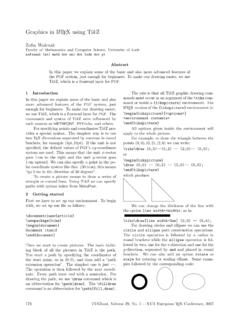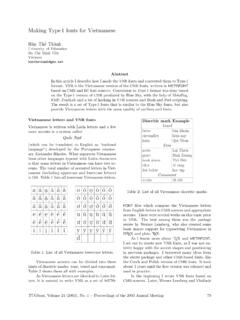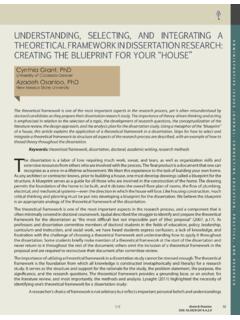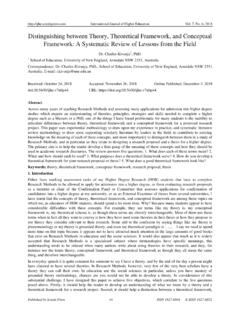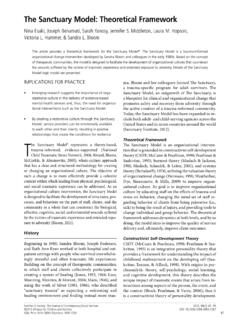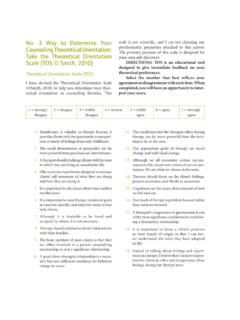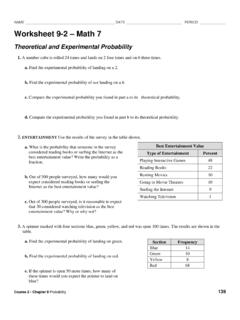Transcription of Theoretical ComputerScience Cheat Sheet
1 Theoretical Computer Science Cheat SheetDefinitionsSeriesf(n) =O(g(n))iff positivec, n0such that0 f(n) cg(n) n (n+ 1)2,nXi=1i2=n(n+ 1)(2n+ 1)6,nXi=1i3=n2(n+ 1) general:nXi=1im=1m+ 1 (n+ 1)m+1 1 nXi=1 (i+ 1)m+1 im+1 (m+ 1)im n 1Xi=1im=1m+ 1mXk=0 m+ 1k Bknm+1 series:nXi=0ci=cn+1 1c 1, c6= 1, Xi=0ci=11 c, Xi=1ci=c1 c,|c|<1,nXi=0ici=ncn+2 (n+ 1)cn+1+c(c 1)2, c6= 1, Xi=0ici=c(1 c)2,|c|< series:Hn=nXi=11i,nXi=1iHi=n(n+ 1)2Hn n(n 1) (n+ 1)Hn n,nXi=1 im Hi= n+ 1m+ 1 Hn+1 1m+ 1 .f(n) = (g(n))iff positivec, n0such thatf(n) cg(n) 0 n (n) = (g(n))ifff(n) =O(g(n)) andf(n) = (g(n)).f(n) =o(g(n))iff limn f(n)/g(n) = an=aiff >0, n0such that|an a|< , n Rsuch thatb s, s Rsuch thatb s, s infn anlimn inf{ai|i n, i N}.lim supn anlimn sup{ai|i n, i N}. nk Combinations: Sizeksub-sets of a sizenset. nk Stirling numbers (1st kind):Arrangements of annele-ment set nk =n!
2 (n k)!k!, nk = 2n,3. nk = nn k ,4. nk =nk n 1k 1 ,5. nk = n 1k + n 1k 1 ,6. nm mk = nk n km k , r+kk = r+n+ 1n , km = n+ 1m+ 1 , rk sn k = r+sn ,10. nk = ( 1)k k n 1k ,11. n1 = nn = 1,12. n2 = 2n 1 1,13. nk =k n 1k + n 1k 1 , nk Stirling numbers (2nd kind):Partitions of annelementset intoknon-empty sets. nk 1st order Eulerian numbers:Permutations 1 2.. non{1,2, .. , n}withkascents. nk 2nd order Eulerian Numbers: Binarytrees withn+ 1 n1 = (n 1)!,15. n2 = (n 1)!Hn 1,16. nn = 1,17. nk nk ,18. nk = (n 1) n 1k + n 1k 1 ,19. nn 1 = nn 1 = n2 , nk =n!, + 1 2nn ,22. n0 = nn 1 = 1,23. nk = nn 1 k ,24. nk = (k+ 1) n 1k + (n k) n 1k 1 ,25. 0k =n1 ifk= 0,0 otherwise26. n1 = 2n n 1,27. n2 = 3n (n+ 1)2n+ n+ 12 , nk x+kn ,29. nm =mXk=0 n+ 1k (m+ 1 k)n( 1)k, ! nm =nXk=0 nk kn m ,31. nm =nXk=0 nk n km ( 1)n k mk!,32. n0 = 1,33. nn = 0 forn6= 0,34.
3 Nk = (k+ 1) n 1k + (2n 1 k) n 1k 1 , nk =(2n)n2n,36. xx n =nXk=0 nk x+n 1 k2n ,37. n+ 1m+ 1 =Xk nk km =nXk=0 km (m+ 1)n k, Theoretical Computer Science Cheat SheetIdentities n+ 1m+ 1 =Xk nk km =nXk=0 km nn k=n!nXk=01k! km ,39. xx n =nXk=0 nk x+k2n ,40. nm =Xk nk k+ 1m+ 1 ( 1)n k,41. nm =Xk n+ 1k+ 1 km ( 1)m k,42. m+n+ 1m =mXk=0k n+kk ,43. m+n+ 1m =mXk=0k(n+k) n+kk ,44. nm =Xk n+ 1k+ 1 km ( 1)m k,45.(n m)! nm =Xk n+ 1k+ 1 km ( 1)m k,forn m,46. nn m =Xk m nm+k m+nn+k m+kk ,47. nn m =Xk m nm+k m+nn+k m+kk ,48. n +m +m =Xk k n km nk ,49. n +m +m =Xk k n km nk .Every tree withnvertices hasn : If the depthsof the leaves ofa binary tree ared1, .. , dn:nXi=12 di 1,and equality holdsonly if every in-ternal node has method:T(n) =aT(n/b) +f(n), a 1, b >1If >0 such thatf(n) =O(nlogba )thenT(n) = (nlogba).Iff(n) = (nlogba) thenT(n) = (nlogbalog2n).
4 If >0 such thatf(n) = (nlogba+ ),and c <1 such thataf(n/b) cf(n)for largen, thenT(n) = (f(n)).Substitution (example): Consider thefollowing recurrenceTi+1= 22i T2i, T1= thatTiis always a power of log2Ti. Then we haveti+1= 2i+ 2ti, t1= Dividing both sides ofthe previous equation by 2i+1we getti+12i+1=2i2i+1+ we findui+1=12+ui,u1=12,which is simplyui=i/2. So we findthatTihas the closed formTi= 2i2i factors (example): Considerthe following recurrenceT(n) = 3T(n/2) +n, T(1) = so that all terms involvingTare on the left sideT(n) 3T(n/2) = expand the recurrence, and choosea factor which makes the left side tele-scope 1 T(n) 3T(n/2) =n 3 T(n/2) 3T(n/4) =n/2 ..3log2n 1 T(2) 3T(1) = 2 Letm= log2n. Summing the left sidewe getT(n) 3mT(1) =T(n) 3m=T(n) nkwherek= log23 the right side we getm 1Xi=0n2i3i=nm 1Xi=0 32 Then we havenm 1Xi=0ci=n cm 1c 1 = 2n(clog2n 1)= 2n(c(k 1) logcn 1)= 2nk 2n,and soT(n) = 3nk 2n.
5 Full history re-currences can often be changed to limitedhistory ones (example): ConsiderTi= 1 +i 1Xj=0Tj, T0= thatTi+1= 1 +iXj= we findTi+1 Ti= 1 +iXj=0Tj 1 i 1Xj=0Tj= soTi+1= 2Ti= 2i+ functions:1. Multiply both sides of the equa-tion Sum both sides over alliforwhich the equation is Choose a generating functionG(x). UsuallyG(x) =P i= Rewrite the equation in terms ofthe generating functionG(x).4. Solve forG(x).5. The coefficient ofxiinG(x) :gi+1= 2gi+ 1, g0= and sum:Xi 0gi+1xi=Xi 02gixi+Xi chooseG(x) =Pi 0xigi. Rewritein terms ofG(x):G(x) g0x= 2G(x) +Xi :G(x)x= 2G(x) +11 forG(x):G(x) =x(1 x)(1 2x).Expand this using partial fractions:G(x) =x 21 2x 11 x =x 2Xi 02ixi Xi 0xi =Xi 0(2i+1 1)xi+ 2i Computer Science Cheat Sheet ,e , , =1+ 52 , =1 52 .61803i2ipiGeneralProbability122 Bernoulli Numbers (Bi= 0, oddi6= 1):B0= 1,B1= 12,B2=16,B4= 130,B6=142,B8= 130,B10= of base, quadratic formula:logbx=logaxlogab, b b2 s numbere:e= 1 +12+16+124+1120+ limn 1 +xn n=ex.
6 1 +1n n< e < 1 +1n n+1. 1 +1n n=e e2n+11e24n2 O 1n3 .Harmonic numbers:1,32,116,2512,13760,4920,363140, 761280,71292520, ..lnn < Hn<lnn+ 1,Hn= lnn+ +O 1n .Factorial, Stirling s approximation:1, 2, 6, 24, 120, 720, 5040, 40320, 362880,..n! = 2 n ne n 1 + 1n .Ackermann s function and inverse:a(i, j) = 2ji= 1a(i 1,2)j= 1a(i 1, a(i, j 1))i, j 2 (i) = min{j|a(j, j) i}.Continuous distributions: IfPr[a < X < b] =Zbap(x)dx,thenpis the probability density function ofX. IfPr[X < a] =P(a),thenPis the distribution function ofX. IfPandpboth exist thenP(a) =Za p(x) : IfXis discreteE[g(X)] =Xxg(x) Pr[X=x].IfXcontinuous thenE[g(X)] =Z g(x)p(x)dx=Z g(x)dP(x).Variance, standard deviation:VAR[X] =E[X2] E[X]2, =pVAR[X].For eventsAandB:Pr[A B] = Pr[A] + Pr[B] Pr[A B]Pr[A B] = Pr[A] Pr[B],iffAandBare [A|B] =Pr[A B]Pr[B]For random variablesXandY:E[X Y] =E[X] E[Y],ifXandYare [X+Y] =E[X] +E[Y],E[cX] =cE[X].
7 Bayes theorem:Pr[Ai|B] =Pr[B|Ai] Pr[Ai]Pnj=1Pr[Aj] Pr[B|Aj].Inclusion-exclusion:Prhn_i=1 Xii=nXi=1Pr[Xi] +nXk=2( 1)k+1 Xii< <ikPrhk^j= inequalities:Pr |X| E[X] 1 ,Prh X E[X] i 1 distribution:Pr[X=k] =pqk 1,q= 1 p,E[X] = Xk=1kpqk 1= ,02429112,04831124,09637138,192411416,38 4431532,768471665,5365317131,0725918262, 1446119524,28867201,048,57671212,097,152 73224,194,30479238,388,608832416,777,216 892533,554,432972667,108,86410127134,217 ,72810328268,435,456107 Binomial distribution:Pr[X=k] = nk pkqn k,q= 1 p,E[X] =nXk=1k nk pkqn k= distribution:Pr[X=k] =e kk!,E[X] = .Normal (Gaussian) distribution:p(x) =1 2 e (x )2/2 2,E[X] = .The coupon collector : We are given arandom coupon each day, and there arendifferent types of coupons. The distribu-tion of coupons is uniform. The expectednumber of days to pass before we to col-lect allntypes ,870,912109301,073,741,824113312,147,483 ,648127324,294,967,296131 Pascal s Triangle11 11 2 11 3 3 11 4 6 4 11 5 10 10 5 11 6 15 20 15 6 11 7 21 35 35 21 7 11 8 28 56 70 56 28 8 11 9 36 84 126 126 84 36 9 11 10 45 120 210 252 210 120 45 10 1 Theoretical Computer Science Cheat SheetTrigonometryMatricesMore Trig.
8 AcBabC(0,-1)(0,1)(-1,0)(1,0)(cos ,sin )Pythagorean theorem:C2=A2+ :sina=A/C,cosa=B/C,csca=C/A,seca=C/B,tan a=sinacosa=AB,cota=cosasina= , radius of inscribed circle:12AB,ABA+B+ :sinx=1cscx,cosx=1secx,tanx=1cotx,sin2x+ cos2x= 1,1 + tan2x= sec2x,1 + cot2x= csc2x,sinx= cos 2 x ,sinx= sin( x),cosx= cos( x),tanx= cot 2 x ,cotx= cot( x),cscx= cotx2 cotx,sin(x y) = sinxcosy cosxsiny,cos(x y) = cosxcosy sinxsiny,tan(x y) =tanx tany1 tanxtany,cot(x y) =cotxcoty 1cotx coty,sin 2x= 2 sinxcosx,sin 2x=2 tanx1 + tan2x,cos 2x= cos2x sin2x,cos 2x= 2 cos2x 1,cos 2x= 1 2 sin2x,cos 2x=1 tan2x1 + tan2x,tan 2x=2 tanx1 tan2x,cot 2x=cot2x 12 cotx,sin(x+y) sin(x y) = sin2x sin2y,cos(x+y) cos(x y) = cos2x s equation:eix= cosx+isinx,ei = :C=A B, ci,j=nXk=1ai,kbk, : detA6= 0 iffAis B= detA detB,detA=X nYi=1sign( )ai, (i).2 2 and 3 3 determinant: a bc d =ad bc, a b cd e fg h i =g b ce f h a cd f +i a bd e =aei+bf g+cdh ceg f ha :permA=X nYi=1ai, (i).
9 HAacbBCLaw of cosines:c2=a2+b2 :A=12hc,=12absinC,=c2sinAsinB2 s formula:A= s sa sb sc,s=12(a+b+c),sa=s a,sb=s b,sc=s identities:sinx2=r1 cosx2,cosx2=r1 + cosx2,tanx2=r1 cosx1 + cosx,=1 cosxsinx,=sinx1 + cosx,cotx2=r1 + cosx1 cosx,=1 + cosxsinx,=sinx1 cosx,sinx=eix e ix2i,cosx=eix+e ix2,tanx= ieix e ixeix+e ix,= ie2ix 1e2ix+ 1,sinx=sinhixi,cosx= coshix,tanx= FunctionsDefinitions:sinhx=ex e x2,coshx=ex+e x2,tanhx=ex e xex+e x,cschx=1sinhx,sechx=1coshx,cothx= :cosh2x sinh2x= 1,tanh2x+ sech2x= 1,coth2x csch2x= 1,sinh( x) = sinhx,cosh( x) = coshx,tanh( x) = tanhx,sinh(x+y) = sinhxcoshy+ coshxsinhy,cosh(x+y) = coshxcoshy+ sinhxsinhy,sinh 2x= 2 sinhxcoshx,cosh 2x= cosh2x+ sinh2x,coshx+ sinhx=ex,coshx sinhx=e x,(coshx+ sinhx)n= coshnx+ sinhnx, n Z,2 sinh2x2= coshx 1,2 cosh2x2= coshx+ 1. sin cos tan 0 010 612 32 33 4 22 221 3 3212 3 210.
10 In mathematicsyou don t under-stand things, youjust get used tothem. J. von 1994 by Steve Computer Science Cheat SheetNumber TheoryGraph TheoryThe Chinese remainder theorem: There ex-ists a numberCsuch that:C rnmodmnifmiandmjare relatively prime fori6= s function: (x) is the number ofpositive integers less thanxrelativelyprime tox. IfQni=1peiiis the prime fac-torization ofxthen (x) =nYi=1pei 1i(pi 1).Euler s theorem: Ifaandbare relativelyprime then1 a (b) s theorem:1 ap Euclidean algorithm: ifa > bare in-tegers thengcd(a, b) = gcd(amodb, b).IfQni=1peiiis the prime factorization ofxthenS(x) =Xd|xd=nYi=1pei+1i 1pi Numbers:xis an even perfect num-ber iffx= 2n 1(2n 1) and 2n 1 is s theorem:nis a prime iff(n 1)! 1 obius inversion: (i) = 1ifi= not square-free.( 1)rifiis the product ofrdistinct (a) =Xd|aF(d),thenF(a) =Xd|a (d)G ad.

